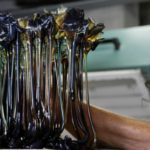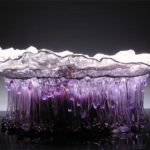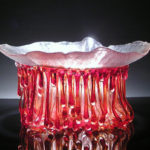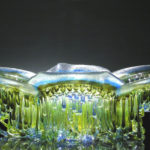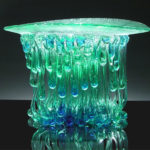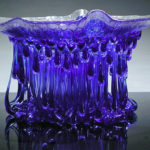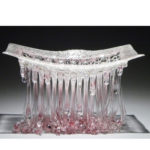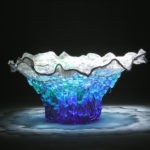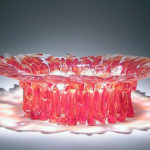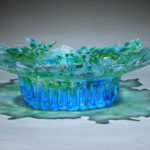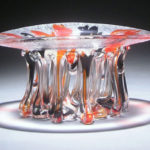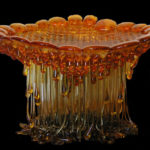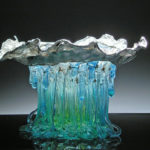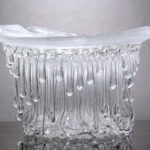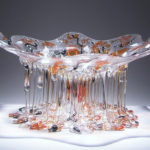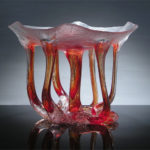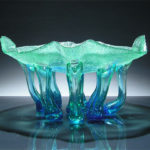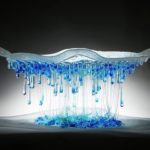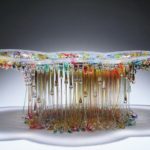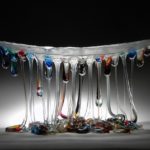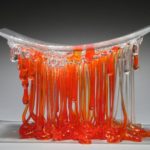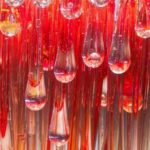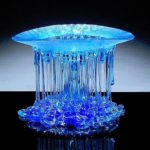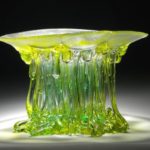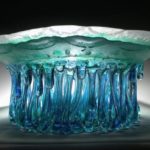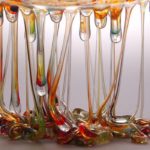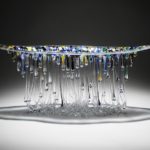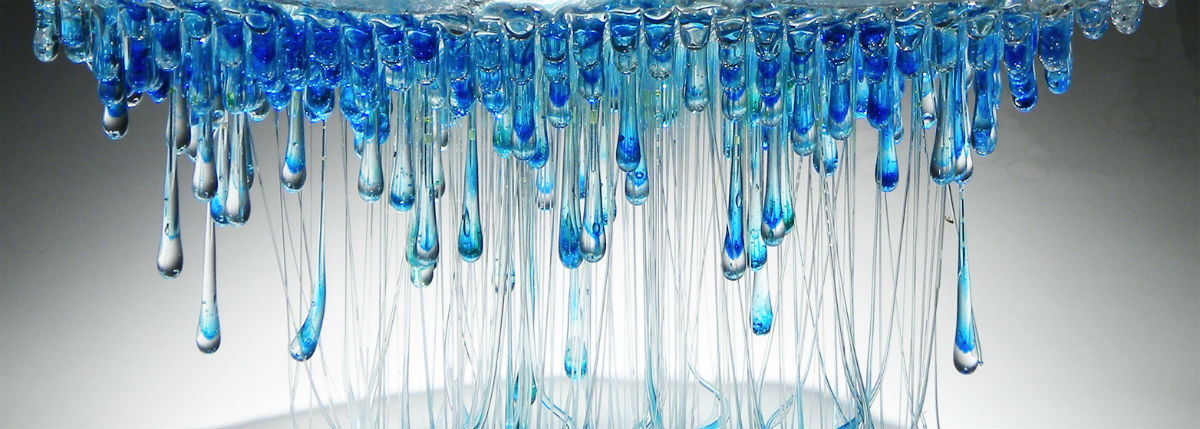
Daniela Forti- The Glass Enchanter.
BIO
She earned a degree in Architecture and Design from the Art School of Rome; after which she had the opportunity to learn in-depth techniques and knowledge by practicing and working at the glass art studio “FORME.”
She developed a particular expressive mastery of this material succeeding in manifesting her own creativity in the divergent process linking fluidity and heat to colors as to the hard and rigid transparency of glass in its natural state.
She became immediately fascinated with famous international glass artists such as Dale Chihuly, Toots Zynsky and Cuny Jutta.
In 1982 Daniela Forti transferred to Tuscany and opened a fully-equipped professional studio. She was given the task to illuminate the prestigious “LYONS CLUB“ of Rome while at the same time collaborating with various Tuscan glassworks.
From Florence to Empoli and all the way to the Arno Valley, her work began to receive praise and success, and not just in Italy. From these fortunate events, she received many requests and opportunities to develop her independent creativity as follow-on orders multiplied. Passing from interior design of prestigious shops to exposition space decoration, to honing her skills in artistic glasswork for sacred and religiuos places, Daniela Forti consolidated her mastery in the correlation between light and glass.
Once the initial decorative phase was over, these elements became established as a purly sculptural vocation giving birth to personal techniques and independent structures. That’s how, cycles and expressions come one after the other, evolving from “TraMe” to the lyrical series of “MEDUSE” passing into the series of “CACTUS” and finishing in the complex and transparent fluidity of the “FRUTTIERE (Fruit baskets)” where fantasy, forms and colors intertwine with plasticity, composition and pure expression of sculptural innovation. Form, color, taste and transparency linked together with a deep understanding of the materials used, translate the silent language of Daniela Forti’s glass sculpture across a glimmer of light and plasticity simplifying the artistic message while facilitating the immediacy of understanding.
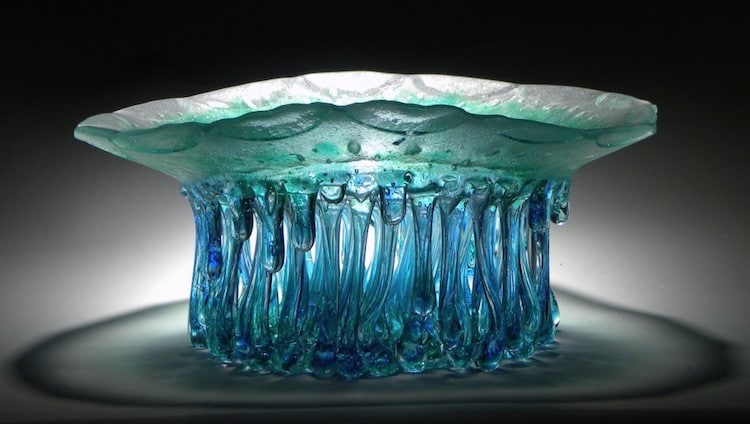
Interview with Daniela Forti
What do you most love about the place you live, and how does it influence your work?
I live and work in a village of 700 in the hills of Lucca where I can admire a breathtaking view, watch sunsets of many colors, and absorb the silence. It is a magical place from which I draw much inspiration. It helps me realize my dreams. I am also fortunate to live and work in a region that has been the cradle of geniuses such as Michelangelo and Leonardo Caravaggio.
What visual references do you draw upon in your work? And how do you choose the colors of your sculptures?
I am very influenced by the sea—its transparency and its mysterious underwater world full of fascinating creatures. I am enchanted by their colors and movements, elements that I try to transform into evocative glass forms.
What is the best part about using glass-fusion technique?
Without a doubt the best moment is when, after the first phase of the fusion, I open the oven and, with the curiosity of a child, see the result I have achieved. Through many years of work, it always manages to make my heart beat fast. It spurs me on to continue my research.
During your career, what are the toughest challenges that you have faced as an artist.
My biggest challenge has been (on behalf of an important multinational company) to design and manufacture more than one thousand unique pieces, organizing everything, and taking care of even the smallest details. In the end, I was successful. I did it well.
What has been your greatest artistic success?
It was participation in an important exhibition, curated by Jean Blanchaert in Milan at Villa Necchi Campigli—and having the honor of getting to know the greatest glass artists in the world.
You admire glass artists such as Dale Chihuly, Toots Zynsky and Cuny Jutta. Are there others?
There are many glass artists that I love. I will mention only a few more: Pipaluk Lake, Simone Crestani, and Ben Young (who loves the ocean too).
What are your thoughts about having your work in the Lions Club in Rome and in private museums around the world?
I feel gratitude knowing that a little bit of me is in all those places.
What advice do you have for beginning artists?
In total autonomy, explore your skills, your creativity. Be giving of your passion, and do not count the hours of work. Go forward with determination to be revolutionary. With determination, create innovative works that do not follow patterns. Above all, do not copy.
For you, how important is recognition and receipt of awards?
Awards and recognition are important. They gratify both the creator and the viewer, and they reward the artist’s hard work!
What is the most important lesson you have learned along the way?
Accept advice and criticism that will encourage you to move forward.
What is your dream creative project?
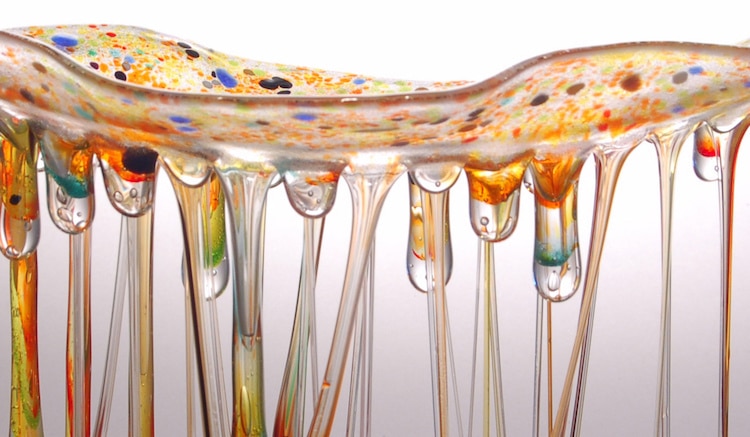
Glass Is a Magical Material …
It lives of light, capturing, transforming, channeling and dispersing it, making it flutter in a concert of color.
It is alchemy which from heaviness, thru flame leads to lightness, to evanescent, to the undefined…
Glass and Fantasy
From the fusion of sand, fire and creativity timeless objects are born. The entire area of Empoli has been synonymous with glass for centuries when the production of glass objects was linked to daily life in the form of wine bottles, oil ampoules, etc.
Following the inspiration and fantasy of the glass masters objects of quality and continuously more refined beauty were created, which today decorate our tables and our homes.
The tradition of glassworks in Tuscany is still very alive today with important companies working in this sector and exporting around the world. From simple objects in green glass, the tradition has evolved into refined techniques and colorful designs.
